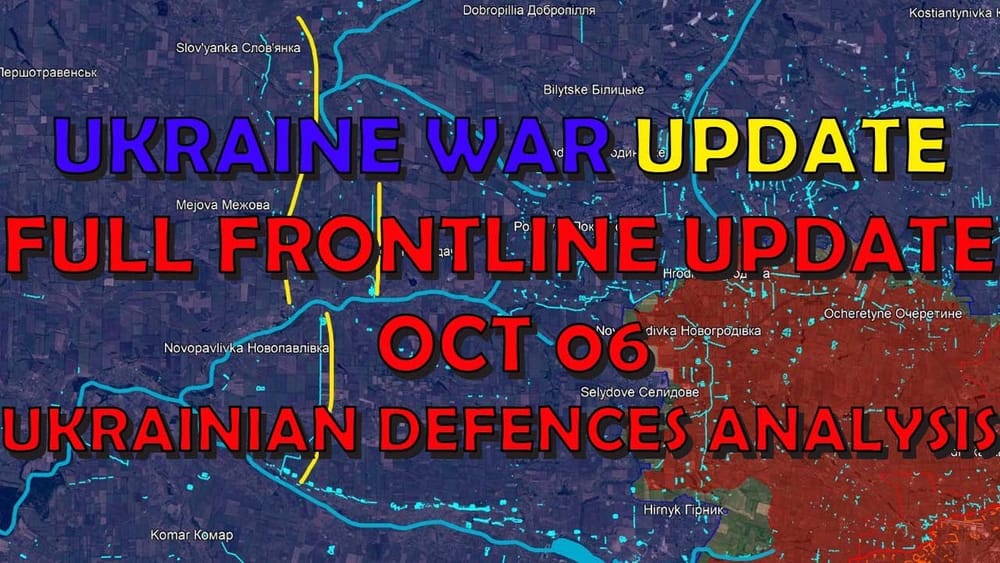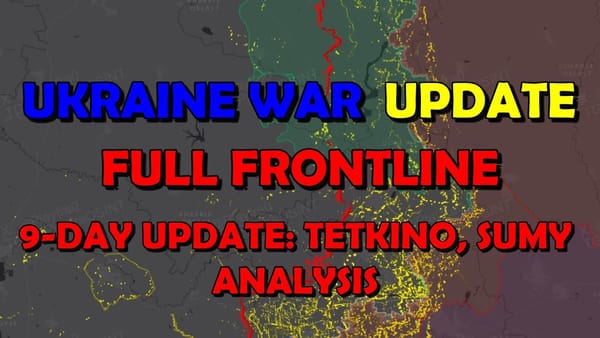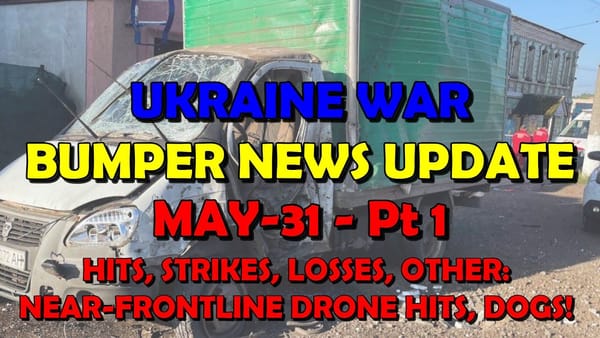Ukraine Conflict: 4-Day Full Frontline Update, Ukraine Fortifications Analysis
Table of Contents 📖
"Trenches are only as good as the defences you've got in them right, you need fortifications plus personnel plus equipment equals defence".
Hello Team
🎦 00:00-00:26⏩
Jonathan welcomes viewers to another ATP Geopolitics video - a Ukraine War Frontline Update for 6th October 2024. He's going to give a "rough and dirty" mapping update as they're in the middle of changing how the mapping is done, and explains the reason for this.
Return to top⤴️
📍 FRONT-LINE UPDATE -🗺️ MAP LEGEND

Mapping Methodology Update
🎦 00:26-02:06⏩
Jonathan explains that the way they've been doing mapping is very labour intensive and they're having to change it. They use three maps:
- Andrew Perpetua (pro-Ukraine)
- Suriyak Maps (pro-Russia)
- Deepstate Maps (pro-Ukraine)
Previously, any changes to the lines on the three maps meant manually updating the lines on the ATP Geopolitics maps. This has been taking 3-4 hours to do. Jonathan gives thanks to JR who has written code that automates the process of updating the Andrew Perpetua map lines which will save a lot of time. Unfortunately, Suriyak maps can't be automated in the same way.
Return to top⤴️
Kursk: Mapping Discrepancies, Grey Zone & Riverine Warfare
🎦 02:06-11:14⏩
Jonathan explains that he got muddled when updating the maps for Kursk as he'd used the Russian defensive lines for Suriyak but the Ukrainian defensive lines for Andrew Perpetua which gave a false impression that the mappers were in agreement. He illustrates the discrepancies between Andrew Perpetua and Suriyak Maps with an example west of Kursk. The difference in the lines drawn by each mapper equates to 10km which is a "massive" discrepancy. He explains that the area east of the Russian lines, in front of the Ukrainian lines is classed as "grey zone" - meaning that control is contested. Andrew Perpetua has stated that he only updates his map when there is enough evidence to support changes, whereas Suriyak Maps will change the map based on even a single source (e.g. a Russian claim) which Jonathan feels illustrates the difference between the two mappers. Jonathan goes on to highlight the importance of understanding that although the mapping may show Russian control, this may not be the case due to the fluid nature of the frontline, and that the Russians may not fully control an area until they are able to "sustain some kind of presence" there. Jonathan uses the area around the river that runs down past Tekino to illustrate this point and how it has shaped the frontline in this location, with both mappers agreeing that the southern outskirts of Tekino, as well as the areas further up the river, are contested. An unconfirmed Russian source has claimed Russian forces have taken Medvedve, pushing Ukrainian troops back across the border. Jonathan notes that this area, if true, represents a fairly small distance (2-3km), but that they'll wait to see if Andrew Perpetua confirms it. There are also claims that Ukrainians are being pushed back from Ubykovka, which again, are unconfirmed. However, Veselya has seen heavy fighting in recent days. Suriyak Maps claims that Ukraine recaptured areas south-east of Vesolove having previously lost it. He also claims that Russia recaptured areas south of Kalinovo (east of Koronovo). Jonathan again points out the difference in mapping between Andrew Perpetua and Suriyak Maps for this area, before moving on to the Vovchansk area.
Return to top⤴️
Vovchansk: Ukrainian Advance & Evidence of Russian War Crimes
🎦 11:14-12:20⏩
Although Jonathan's maps show no change in this area, a Ukrainian source has claimed that they have made advances in Vovchansk. This has not been reflected in the maps yet. They've allegedly taken control of the northern part of the settlement, taking back control of a road that runs north-west. He notes that there's evidence that Russian forces executed 4 Ukrainian POWs when they were in control of the aggregates plant in Vovchansk.
Return to top⤴️
Kupyansk-Svatove-Kreminna: Russian Advances & Oskil River
🎦 12:20-14:06⏩
Jonathan highlights the ongoing fighting along this axis and notes that the Russians have made advances near Pischane, pushing Ukrainian forces back to within 2-3km of the Oskil River. He draws attention to the automated pins on his map which show that Suriyak maps has been ahead of Andrew Perpetua in showing Russian advances in this area and praises Suriyak maps' prescience, which may also indicate greater accuracy. He goes on to say that Suriyak maps may simply need "less of a threshold" compared to Andrew Perpetua, before highlighting Russian gains south of Kolomckyhivka, south of Stelmakhivka.
Return to top⤴️
Lyman-Siversk-Chesyvyar: Static Frontline & Importance of Ukrainian Defence
🎦 14:06-16:48⏩
Jonathan notes that although the frontline remains static in some places, with no changes for several days in areas such as Chesyvyar, this does not mean that it isn't active. He illustrates this point by highlighting the difference between Andrew Perpetua and Suriyak Maps around the Tornyi area where Ukrainian forces have been pushing back against Russian advances. Russian forces have taken control of Makivka and Nevske but Ukrainians are holding strong in Torske, pushing Russian forces back from the water features to the south-east. Suriyak Maps claims that Russian forces have taken Novosadove and are attacking positions around the water features. Suriyak Maps also claims that Russia has taken more land north of Pischane. Jonathan goes on to point out that despite Russian attempts to advance in numerous locations along the frontline, some areas remain remarkably quiet. Both Chesyvyar and the area south of it (around Torska and Terny) are two such locations where fighting has been limited in recent days, despite expectations of a renewed Russian offensive before the end of summer.
Return to top⤴️
Donetsk: Significant Russian Advances & Ukrainian Fortifications
🎦 16:48-40:25⏩
Jonathan points out that whilst the northern part of the Donestk Oblast frontline remains largely static, significant Russian advances have taken place around Selydove, with Andrew Perpetua showing Russia taking a large swathe of land, pushing the line back to Tsikorina. Suriyak maps confirms this, showing Russian forces in control of Tsikorina itself, with fighting ongoing on the western outskirts. Further Russian gains are noted south of Karlivka as Russian forces advance on Krasnohorivka from two directions (south from Karlivka and east from the direction of Mariinka) with Andrew Perpetua suggesting that Russian forces now control the area south of Karlivka to the south of Novomykhailivka. Jonathan goes on to discuss the fortifications that are being built around Prokrovsk, introducing a thread by Clement Mollin (@clement_mollin) about Ukrainian defences around Prokrovsk. Jonathan agrees with Mollin's assertion that the main Ukrainian trenchline is the reason why the Russian advance has stalled around Selydove and Prokrovsk and expresses some surprise that Ukrainian defences were located so close to Prokrovsk. He speculates that Ukrainian forces may not have foreseen the speed at which Russian forces would be able to take Avdiivka which prevented the construction of adequate defences, as these cannot be built near the frontline due to the risk of being hit by artillery. Jonathan surmises that, as Avdiivka had been held by Ukrainian forces since 2014, they did not anticipate that it would fall quickly, whereas in reality, Russian use of combined arms (particularly the "aviation advantage" afforded by guided glide bombs) quickly smashed Ukrainian defences. This has led to a belated, but necessary, increase in the pace and scale of defensive construction around Prokrovsk. Jonathan points out that Clement Mollin has identified two rings of defences around Prokrovsk, with Ukrainian forces now building fortifications on the road to Dnipro (the Dnipro River, east of the city of Dnipro), such is the importance of these defences. Mollin identifies the 23rd Engineering Positional Regiment of the Ukrainian Support Forces as having played a crucial role in constructing defensive fortifications (including Dragon's Teeth) east of Prokrovsk. Mollin also highlights the fact that whilst some units have benefitted from crowdfunding campaigns (such as those run by Konstantin), many have had to rely on basic tools, such as shovels. Jonathan expresses frustration at the lack of adequate Ukrainian fortifications which, he believes, is in stark contrast to the robust fortifications constructed by Russian forces. This point is illustrated with an example from early in the war when Jonathan, when mapping Russian trenchlines, noticed how extensive these were, covering a huge area, including all of the treelines. This has made it extremely challenging for Ukrainian forces to make any advances. The success of Russian fortifications in stalling the May 2023 counteroffensive is cited as evidence for the necessity of building robust defences. Jonathan agrees with the commentator who notes that Russian forces “dig everywhere” and suggests that the widespread use of thermite munitions by both sides is a direct result of the extensive network of trenches that have been dug. He goes on to say that one of the key lessons from the war so far is the importance of aviation assets, which are able to destroy fortified positions relatively easily. The lack of Ukrainian airpower remains a critical vulnerability. Jonathan highlights the fighting around Vodiane (north of Vasylivka), where Ukrainian forces were eventually forced to cede ground despite putting up stiff resistance. He notes how the flat, open terrain around this area made it extremely difficult for Ukrainian forces to hold back Russian advances, and contrasts this to the fighting around areas with more tree cover, such as those to the south and west of Velyka Novosilka, where Ukrainian troops were able to hold out for much longer. This point is further emphasised by describing the ease with which Russian forces were able to advance in the Stepova area, which had few Ukrainian defensive positions. Jonathan refers to maps he made of Ukrainian defensive lines in response to the fall of Avdiivka and notes that, thankfully, the situation is broadly the same as it was then, with lines 3 and 4 still holding, despite the loss of the first two. Returning to the Clement Mollin thread, Jonathan expresses relief that Ukrainian forces are now constructing a new line of defences to the rear of Prokrovsk, stretching from Mykhailivka to Slovyansk. Mollin also points out that the new defensive line is being built along the border of Donetsk and Dnipro oblasts and speculates that this is for both political and military reasons: politically, it represents a line that Ukraine may be unwilling to concede, and militarily, it benefits from the presence of a number of rivers. Jonathan goes on to describe the topography of the area around Prokrovsk, highlighting the importance of the high ground (around 200m) and the presence of rivers for defensive purposes. Mollin states that the Ukrainian trenches around Prokrovsk are too wide, making them more susceptible to drone attack. This is a view shared by an ex-Serbian soldier who contacted Mollin. Jonathan agrees with this assessment, pointing out that whilst larger trenches allow greater freedom of movement, they are easier for loitering munitions to enter. This point is contrasted with the images of well-constructed and fortified trench lines, which are much more resistant to attack. However, these types of fortifications are time-consuming and require manpower and resources to construct. Jonathan finishes this section of the video by emphasising the importance of fortifications, especially in the face of sustained Russian air attack.
Return to top⤴️
Vuhledar: Russian Gains and Strategic Significance
🎦 40:25-42:44⏩
Small Ukrainian gains are noted to the north-west of Vuhledar as Ukrainian forces seek to capitalise on recent momentum. Further Russian gains are observed north of Kostyantynivka as Russian forces advance south towards the river. Jonathan believes that Russian forces will be seeking to create a more even frontline running from the north of Kostyantynivka to the south of Vuhledar, and points out that the fall of Vuhledar may result in further Russian advances.
Return to top⤴️
Wrap Up
🎦 42:44-44:12⏩
Jonathan sums up by saying that although the Russians are continuing to make gains in some areas, these are less significant than they were previously. The slowing down of the Russian advance is attributed to increased Ukrainian resistance, particularly around Prokrovsk, as well as the onset of the muddy season, which will make offensive operations much more difficult. He concludes the video by pondering whether Russia will be able to integrate the new wave of 130,000 conscripts that they are seeking to mobilise over the next three months.
Return to top⤴️



